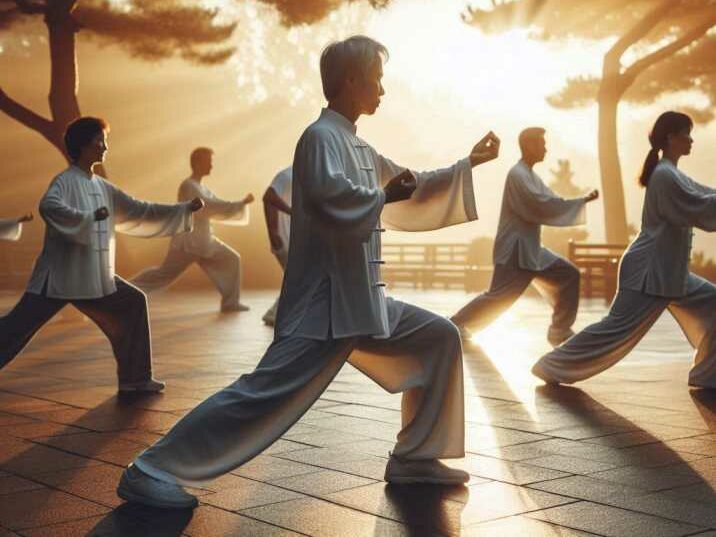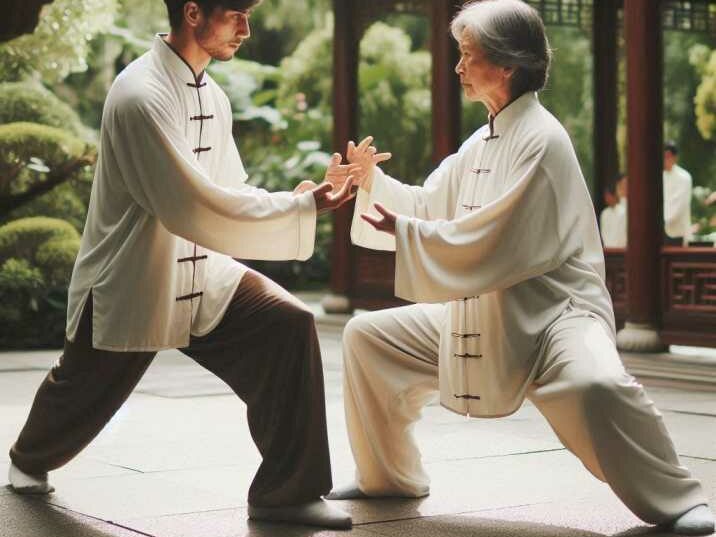Table of Contents
Table of Contents
- Introduction
- Is Tai Chi a Martial Art
- The Origins of Tai Chi
- Historical Background
- Martial Arts Context
- The Principles of Tai Chi
- Yin and Yang
- Qi (Chi) and Energy Flow
- The Five Elements Theory
- Tai Chi as a Martial Art
- Techniques and Applications
- Push Hands (Tui Shou)
- Tai Chi Weapons
- Modern Perceptions of Tai Chi
- Health and Wellness
- Tai Chi in Competitive Martial Arts
- Misconceptions and Stereotypes
- The Philosophical Dimension
- The Taoist Influence
- Mind-Body Connection
- The Training Process
- Learning the Forms
- Partner Training
- Advanced Techniques
- Tai Chi in the Modern World
- Integration with Other Practices
- Global Spread and Cultural Exchange
- FAQs
- Conclusion
Introduction
When most people hear the term “Tai Chi,” they often picture serene individuals moving slowly and gracefully in a park at dawn. Often associated with health benefits and relaxation, Tai Chi is commonly perceived as a form of meditative exercise. However, beneath the surface of these gentle movements lies a rich history rooted in martial arts. So, is Tai Chi a martial art? The answer is more complex than a simple yes or no.
This blog post will delve deep into question is Tai Chi a martial art, the origins, principles, and applications of Tai Chi to uncover its true nature. Prepare to have your perceptions challenged and broadened as we explore Tai Chi from multiple angles, addressing its historical, philosophical, and practical dimensions.

The Origins of Tai Chi
Historical Background
Tai Chi, also known as Tai Chi Chuan (太极拳), translates to “Grand Ultimate Fist.” It has its roots in ancient China, with its development traditionally attributed to the legendary Taoist monk Zhang Sanfeng in the 12th century. However, historical records suggest that Tai Chi as we know it today began to take shape in the 17th century with Chen Wangting of the Chen Village in Henan Province. Over the centuries, Tai Chi evolved, giving rise to several styles, including Chen, Yang, Wu, and Sun, each with its unique characteristics and emphases.
Martial Arts Context
To understand whether Tai Chi is a martial art, we need to consider its development within the broader context of Chinese martial arts, known as Wushu. Tai Chi emerged during a time when martial arts were integral to self-defense, military training, and physical conditioning. The early practitioners of Tai Chi were well-versed in combat techniques, and the art was designed to be an effective form of self-defense.
The Principles of Tai Chi
Yin and Yang
At the heart of Tai Chi is the Taoist philosophy of Yin and Yang, representing the duality and interdependence of opposing forces. Tai Chi movements embody this principle, balancing softness with hardness, yielding with attacking, and slow with fast. This dynamic interplay is not just for aesthetics but serves a practical purpose in martial applications.
Qi (Chi) and Energy Flow
Another fundamental principle of Tai Chi is the cultivation and flow of Qi (vital energy). Practitioners believe that smooth and continuous movements help circulate Qi throughout the body, promoting health and vitality. In a martial context, this cultivated energy can be directed to enhance power and effectiveness in techniques.
The Five Elements Theory
Tai Chi also incorporates the Five Elements Theory (Wood, Fire, Earth, Metal, and Water), which describes the interactions and relationships between different aspects of nature. These elements correspond to specific movements and strategies within Tai Chi, providing a framework for both health practices and combat techniques.
Tai Chi as a Martial Art
Techniques and Applications
Despite its gentle appearance, Tai Chi includes a wide range of martial techniques. Here are some of the key components:
1. Strikes and Kicks
Tai Chi forms contain various strikes, punches, and kicks. These techniques are often hidden within the flowing movements but can be applied with significant force when executed correctly.
2. Joint Locks and Throws
Many Tai Chi movements involve joint locks and throws, which are used to control or incapacitate an opponent. These techniques require precise timing, sensitivity, and an understanding of leverage.
3. Defensive Maneuvers
Tai Chi emphasizes defense over offense. Techniques such as yielding, redirecting, and neutralizing attacks are central to its practice. These principles allow practitioners to use an opponent’s force against them, often with minimal effort.
Push Hands (Tui Shou)
A unique aspect of Tai Chi training is “Push Hands” (Tui Shou), a partner exercise that develops sensitivity, balance, and responsiveness. In Push Hands, practitioners learn to feel and interpret their partner’s movements and intentions, honing their ability to maintain stability and control in a confrontational situation.

Tai Chi Weapons
In addition to empty-hand techniques, Tai Chi includes training with various traditional weapons, such as the straight sword (jian), broadsword (dao), spear, and staff. Weapons training further develops coordination, strength, and martial skills.
Modern Perceptions of Tai Chi
Health and Wellness
In contemporary society, Tai Chi is often practiced for its health benefits. Studies have shown that regular Tai Chi practice can improve cardiovascular health, balance, flexibility, and mental well-being. These benefits have contributed to its popularity as a form of exercise, particularly among older adults.
Tai Chi in Competitive Martial Arts
While Tai Chi is not as prominently featured in competitive martial arts as other disciplines like Karate or Taekwondo, it does have a presence in events such as Wushu competitions and Tai Chi-specific tournaments. These competitions often include forms demonstrations and Push Hands matches, showcasing the art’s martial aspects.
Misconceptions and Stereotypes
One of the biggest challenges in recognizing Tai Chi as a martial art is overcoming misconceptions and stereotypes. The slow, meditative nature of Tai Chi practice can lead to the assumption that it lacks martial efficacy. However, experienced practitioners understand that the slow movements are a training method to develop precision, control, and internal strength, which can be applied dynamically in combat.
The Philosophical Dimension
The Taoist Influence
Tai Chi’s philosophical foundation is deeply rooted in Taoism, which emphasizes harmony with nature, balance, and effortless action (wu wei). These principles are not only reflected in the movements but also in the approach to conflict. Tai Chi teaches practitioners to remain calm, centered, and adaptable, using minimal force to achieve maximum effect.
Mind-Body Connection
A key aspect of Tai Chi practice is the integration of mind and body. The focus on mindfulness and intentional movement fosters a deep connection between mental and physical states. This holistic approach is essential for both health benefits and martial proficiency.
The Training Process
Learning the Forms
Tai Chi training typically begins with learning the forms, which are sequences of movements that embody the art’s principles and techniques. Each form is a comprehensive exercise in balance, coordination, and internal energy cultivation.
Partner Training
As students progress, they engage in partner training exercises, such as Push Hands and applications practice. These exercises help develop sensitivity, timing, and the ability to apply techniques in a dynamic context.
Advanced Techniques
Advanced training includes more complex forms, weapons practice, and in-depth exploration of martial applications. At this stage, practitioners refine their skills and deepen their understanding of Tai Chi’s principles.
Tai Chi in the Modern World
Integration with Other Practices
In recent years, Tai Chi has been integrated with various other practices, such as physical therapy, sports training, and stress management programs. Its versatility and adaptability make it a valuable tool in diverse fields.
Global Spread and Cultural Exchange
Tai Chi has gained worldwide popularity, transcending cultural boundaries. This global spread has led to a rich exchange of ideas and practices, further enriching the art and its applications.
Conclusion
So, is Tai Chi a martial art? The answer is a resounding yes. While it is widely recognized for its health benefits and meditative qualities, Tai Chi’s origins and principles are deeply rooted in martial arts. Its techniques, training methods, and philosophical foundations all point to its efficacy as a form of self-defense and combat training. By understanding the full spectrum of Tai Chi, from its historical roots to its modern applications, we can appreciate its richness and complexity. Whether practiced for health, martial proficiency, or personal growth, Tai Chi offers a unique and profound journey for those who delve into its depths.
FAQs about is Tai Chi a Martial Art?
1. Is Tai Chi only for older adults?
No, Tai Chi is suitable for people of all ages. While it is popular among older adults due to its low-impact nature and health benefits, younger individuals can also practice Tai Chi for its martial applications and overall wellness benefits.
2. Can Tai Chi be used for self-defense?
Yes, Tai Chi includes a variety of techniques such as strikes, joint locks, and throws that can be used effectively for self-defense. However, practical application requires dedicated training and practice.
3. How long does it take to learn Tai Chi?
The time it takes to learn Tai Chi varies depending on the individual’s dedication, frequency of practice, and prior experience. Basic forms can be learned in a few months, but mastering Tai Chi as a martial art can take years of consistent practice.
4. Is Tai Chi effective in a real fight?
While Tai Chi can be effective in a real fight, its effectiveness depends on the practitioner’s level of skill, understanding of techniques, and ability to apply principles under pressure. Tai Chi focuses on yielding and redirecting force, which can be highly effective in self-defense.
5. Do I need any special equipment to practice Tai Chi?
No special equipment is required to practice Tai Chi. Comfortable clothing and a flat surface are sufficient. For advanced training, practitioners might use traditional weapons such as the sword or staff.


